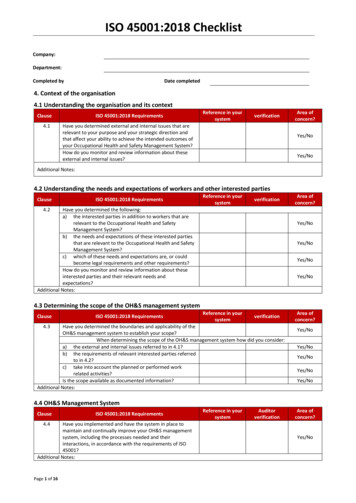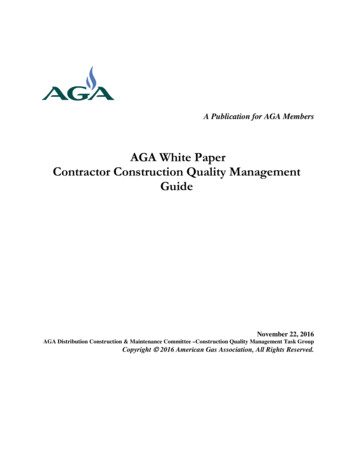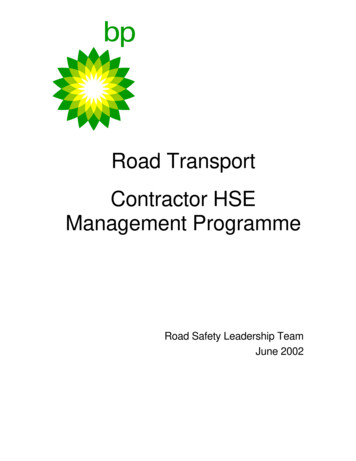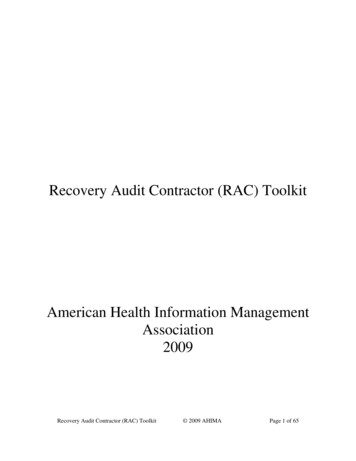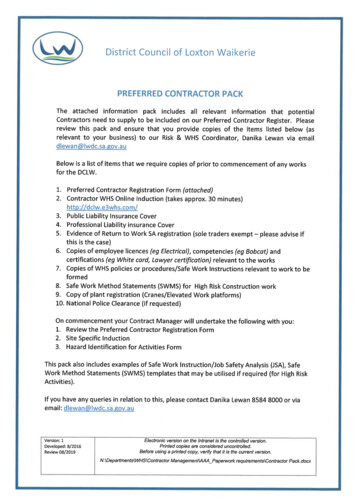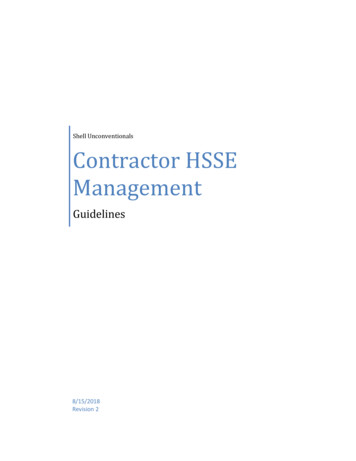
Transcription
Shell UnconventionalsContractor HSSEManagementGuidelines8/15/2018Revision 2
Table of ContentsContractor HSE Management Guidelines . 3Purpose . 3Governance . 3Overview of CSM Process . 3Definitions: . 4Contract Segmentation . 6Pre-assessment Activities . 6Contract HSSE Risk Determination. 7Assessment Types . 7ISN Assessment . 9CSM Assessment . 10Banding Classifications. 11Banding Results and Findings. 12Communication Strategy . 12Red Banded Contractors . 13Amber Banded Contractors . 13Green Banded Contractors . 13Gap Closure Plans . 13Documented Exceptions . 13Banding Review . 14Banding Review Frequency . 14Changes in HSSE MS After Completed Assessment . 15Non-ISN Assessments Within UA . 15Subcontractor Management . 15Subcontractor Management Capability Assessment Matrix (Minimum UA Requirements) . 15Matrix Considerations . 15Determining Subcontracting Capability within the CSM Assessment . 16Subcontractor Management Assessment . 16Responsibility and Performance of the Contractor . 16CSM Assessment and Subcontractor Focus Assessment Results . 17Non Approved Contractors . 17Page 2
Contract Management Plan . 17Contract HSSE Plan. 17Post Award Performance Monitoring . 18Performance Penalty . 18Additional “Fit for Purpose” Post Award Support . 18Virtual Engagements . 18Local Contracting Goals . 19Local Contracting Process Map . 19Internal Performance Reviews . 19Performance Plan. 19Stakeholder CSM Process Review . 19Registry of Changes. 19Contractor HSE Management GuidelinesPurposeTo provide guidelines, consistency and understanding of the Unconventionals Contractor SafetyManagement (CSM) process requirements for evaluating contractor HSE Management Systems includingtypes, frequency and the depth of the reviews, from pre-award through post-award.GovernanceThe Contract Safety Management process is governed by Control Framework. To achieve compliancewith these expectations, the CSM process is implemented based on the below expectations. As theControl Framework is modified, the guidelines will be amended to ensure alignment.Overview of CSM ProcessThe Contract Holder is responsible for determining whether the contractor has the capability andresources to manage HSSE risks. The CSM Specialist supports the Contract Holder in this responsibilitythrough the application of the CSM process. The primary goal of the CSM process is to determine if thecontractor’s HSE Management System can effectively identify and manage HSE risk based on theservices provided, throughout the life of the contract. This is determined through the results andsubsequent banding of a contractor derived from an ISNetworld (ISN) or CSM Assessment. ISN is a thirdparty database used to house banding results, assessment outcomes, HSSE performance andinformation related to the HSSE management system of the contractor.Page 3
During the post award contract stage, additional activities are directed toward supporting the ContractHolder and Contract Management Team to improve contractor HSSE performance. Banding mayfluctuate based on HSE performance and can be manually adjusted through the application of aPerformance Penalty. Through engagements, both at the contractor’s office and worksite locations, theCSM Specialist supports the Contract Holder to validate that the contractor is aligned with Shell’sexpectations and pursuit of Goal Zero.The CSM Specialist works directly with Contracts and Procurement (CP) to provide training andknowledge support of the Contract Holders and Owners. This includes guidance to ensure the correctHSSE risk has been assigned to a contractThe 13 Task Matrix and CSM Process Executive Summary may be used as quick references to assist withunderstanding and communicating the Process.Definitions: Banding Review – a review of a contractor’s demonstrable closure of corrective actions from aprevious CSMA which includes review of their CSM Gap Closure Plan, HSE Performance and FieldFeedback. COR – Certificate of Recognition (Canada Only) Sharp – Contractor Management System – a database utilized by CP to track contractor-relatedinformation. Contract HSSE Plan – Plan currently developed by the Contract Management Team to manage theHSSE risk throughout the life cycle of the contract. Contract HSSE Risk – Highest unmitigated risk to the worker that is associated with the work scopeof the contract. CMP - Contract Management Plan – Maintained by Contracts and Procurement, it outlines actionsthat support contract objectives and define activities, milestones, resources and specificperformance opportunities that need to be monitored during the contract lifetime. CMT – Contract Management Team is comprised of Shell employees assigned to manage acontract. The team typically includes the Contract Owner, Contract Holder, a CP Representative,an HSSE Focal (which can be either a CSM Specialist or HSEiB) and Finance. CSMA – Contractor Safety Management Assessment; on-site verification of a contractor’s HSEManagement System conducted by a CSM Specialist. CP – Contracts & Procurement Gap Closure Plan – Developed by the contractor detailing how CSMA or Banding Review Findingswill be corrected and mitigated. High/Medium Risk Prequalification Variance – form utilized to document how HSSE concerns willbe managed and to approve use of contractors that are exempt from prequalificationrequirements. HSE MS – Health Safety Environment Management System. HSEiB – HSE representative (coordinator, technician, etc.) from the business. HSE IP – HSE Improvement Plan developed annually by the contractor to address HSEimprovement opportunities identified by the contractor.Page 4
ISN – ISNetworld is a third party online data service used to house banding results, assessmentoutcomes, HSSE performance and information related to the HSSE management system ofcontractors.ISNA – ISN Assessment that utilizes a standardized questionnaire, safety performance, and adetailed Review and Verification (RAVS) of the policies and procedures of the contractor’s HSE MSin comparison to industry as well as Shell’s minimum HSE requirements and assigns a DashboardScoreKPI – Key Performance IndicatorMode – classification of a contract which establishes the HSE MS that will be utilized to managethe operations throughout the contract duration. Contracts can be Mode 1, 2, 3 or Multi-mode Mode 1: The contractor provides people, processes and tools for the execution of thecontract under the supervision, instructions and HSSE-MS of Shell. The contractor has amanagement system to provide assurance that the personnel for whom it is responsibleare qualified and fit for the work and that the processes, tools, materials and equipmentthey provide are properly maintained and suitable for the contract. Mode 2: The contractor executes all aspects of the contract under its own HSSE-MS,providing the necessary instructions and supervision and verifying the proper functioningof its HSSE-MS. Shell has the right to verify the overall effectiveness of the HSSE-MScontrols in place and assuring that both the Shell and contractor HSSE-MS are compatible. Mode 3: Work is conducted at contractor site and HSSE Risks are managed under theContractor’s HSSE-MS. Contractor operates within its own HSSE-MS that has no interfaceswith the client HSSE-MS. Multi-mode: In certain circumstances, contracted services span a number of activitiesand/or are delivered at various locations. In these circumstances, contracts are identifiedas multi-mode and work is broken down into smaller, identifiable activities each with amode and party assigned for management of HSSE risks. Depending upon location, HSSErisks are managed under the contractor’s HSSE-MS or Company HSSE-MS.MSQ - Management System Questionnaire. References the HSSE Prequalification in ISN.Operational Contracts – see “Contract Segmentation” table belowRed Contractor Variance – document utilized to capture requirements and management approvalto utilize a contractor that has not met the expectation of the CSM AssessmentRT – Road TransportRT Assessment – assessment conducted by the Logistics group utilizing the Road TransportationAssessment Protocols and tools.Strategic Contracts – see “Contract Segmentation” table belowSFA – Subcontractor Focused Assessment Tactical Contracts – see “Contract Segmentation” table belowPage 5
Contract SegmentationSegmentation is based on three driversContract HSSE risk: responsibility of CH and HSSE to determineBusiness Criticality: determined by CH and CP LeadCommercial Complexity: determined by CP LeadThe outcomes of the three risk drivers determine the Aggregated Contract risk classification. Decisionson the level of rigor to determine HSSE capability are based on the Contract HSSE risk andSegmentation.ContractHSSE RiskLowMediumHighBusiness CriticalityCommercialcomplexityNoNoOne or both YesNoNoOne YesBoth YesNoNoOne or both YesAggregatedContract cticalStrategicContract HSSE Risk is the highest unmitigated risk to the worker that is associated with the work scopeof the contract.A contract is considered business critical if it is supporting an activity that is critical to ongoing businessoperations. The failure of a business-critical contract to provide materials would havesevere/catastrophic effects on operations, assets or individuals.Contracts that are considered commercially complex involve the following aspects: Uncertainty in execution Numerous parties involved and high degree of interface requirements Wide variety of products provided with complex pricing schemes Incentive models that are linked to contract performance scorecard outcomes Actual Contract Value (ACV) exceeding 100MPre-assessment Activities1. A new contractor is identified for use by the business. CSM is notified.2. Mode, HSSE Risk, and Segmentation are determined / confirmed by the Contract Holder withinput from HSSE, CSM and CP. Designations are documented by CP in Sharp.3. The initial assessment and/or Banding Review occurs based on the following, with exceptions tobe agreed upon by CSM and HSE in the business:SegmentationContract HSE RiskGeneral ContractsRoad Transport RT OnlyISNAISNA RTCSMACSMA RTN/ART OnlyISNA or CSMACSMA RTCSMACSMA RTPage 6
Contract HSSE Risk DeterminationEach contract must be assessed to determine the HSSE risk. This is accomplished by evaluating theactivities that are covered in the contract work scope and performed by that contractor. The activitywith the highest level of HSSE risk determines the overall HSSE risk of the contract. Shell does notclassify the contractor as an HSSE risk but rather assesses their HSE MS and ability to manage that risk.This note provides further guidance on the assignment of contract HSSE risk.1. High or medium contract HSSE risk is determined only for activities undertaken by “ReportingContractors” otherwise referred to as Mode 1 or 2 contracts.2. Contract HSSE risk is concerned with risks leading to incidents during the performance of thecontract. Consequential risks through bad design or materials are addressed through thetechnical specification of the contract.3. Some activities are not hazardous in themselves but become hazardous because of exposurethrough the location or through personnel being transported. In such cases, Shell allocates thecontract HSSE Risk to the contract that can affect the risk. In other words, only the contractorperforming the activities and not those simply exposed to the hazard.4. Competence of contractors and subcontractors is critical. Even low contract HSSE risk activitiescan lead to incidents (immediate or delayed) if the competence of the workers involved is notadequate. The contract HSSE Risk categorization is based on the assumption that the work willbe done by competent workers that are properly trained to perform their assigned tasks.5. Many contracts involve contractor companies driving themselves, or their colleagues, betweenworksites or in mobilization activities. Where these activities are explicitly included within thescope of the contract and they are undertaken by a “Reporting Contractor”, the contract cannothave low contract HSSE Risk.Assessment TypesThe ISNA and CSMA supports the Contract Holder to determine the capability and resources of thecontractor to manage HSSE risk in the following areas.3.1 The Contractor Company must show past and current HSSE performance.3.2 The Contractor Company must have a documented process, including procedures and workinstructions, or an HSSE – MS which shows that the contractor can manage the HSSE risk.3.3 The Contractor Company must have a Competence Assurance process for its personneland assure they are competent.3.4 The Contractor Company must show that its training program supports the management of theHSSE Risks.3.5 The Contractor Company must have a fitness to work process for its personnel and assure theyare fit to work.3.6 Tools or equipment that the Contractor company plans to use must be suitable for the job andsafe to use.3.7 Before contract award, confirm that the contractor company meets 3.1 to 3.6 above. Use anapproval process for exceptions and record the outcome.3.8 Before the contractor company awards a subcontract, check that the Contractor has assessedthe subcontractor’s ability to meet requirements 3.1 to 3.6.Page 7
Requirement in Manual Section3.1 The Contractor Companymust show past and current HSSEperformanceISNAHSSE PerformanceStatisticsWorkers’ CompensationPremium Rate Statement(Canada) or Current andVerified ExperienceModifier (U.S.),MSQ – Audits andReviews, Investigationand Reporting, HSSEAdditional FeaturesRAVS - Safe WorkProcedures by WorkType, JourneyManagementMSQ - Policy andStrategic Objectives,MSQ - HEMP:Assessment,Communication ofHazards, ExposureMonitoring, PPE, Wasteand Environmental,MSQ - Road and VehicleSafety, Planning andProceduresCSMAElement 6 Implementation andPerformance Monitoring3.3 The Contractor Companymust have a CompetenceAssurance process for itspersonneland assure they are competentRAVS - Job Competency,Short Service Employeeand New EmployeeElement 3. Organization,Responsibilities, Standards andDocumentationSub-element CompetencyAssuranceRequirement in Manual Section3.4 The Contractor Companymust show that its trainingprogram supports themanagement of the HSSE Risks.ISNAMSQ Manager/Supervisor/HSESupport Competency andTraining, CompetenceCSMAElement 3. Organization,Responsibilities, Standards andDocumentation3.2 The contractor Companymust have a documentedprocess, including proceduresand work instructions, or an HSSE– MS which shows that thecontractor can manage the HSSEriskPage 8CSM Assessment verifies presenceof HSSE MSElement 1. Leadership andCommitmentElement 3. Organization,Responsibilities, Standards andDocumentationSub-element Training ofManagers/Supervisors and HSECritical PositionsElement 4 Hazards and EffectsManagementSub-element Risk Assessment andControlsElement 5. Planning and proceduresSub-element Safe WorkProcedures and Programs
and General HSE Training,Specialized HSE TrainingSub-element General HSE Trainingand Orie
Sharp – Contractor Management System – a database utilized by CP to track contractor-related information. Contract HSSE Plan – Plan currently developed by the Contract Management Team to manage
